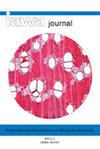不穿孔管胞和狭窄血管在被子植物木材容量中的作用
IF 3.5
3区 农林科学
Q2 FORESTRY
引用次数: 1
摘要
Sherwin Carlquist详细描述了各种各样的不穿孔气管成分(ITEs)——libriform纤维、纤维管状、真管状和血管中心管状。然而,在定量意义上,由于很少有结构-功能研究测量ITE的性质,因此在有血管被子植物木材中存在的不同类型ITE的功能意义仍然不清楚。具有丰富凹坑和宽凹坑边界的岩石(维管管、维管中心管胞和真管胞)已被证明具有导电性,由于这种导电性和大量凹坑,它们也可能有助于木材电容。研究人员重新分析了30个温带被子植物树种的数据集,记录了真管、血管中心管和维管管的存在/缺失,包括导管(conduits15)分数和导管-导管(conduits15)接触分数(conits15被定义为类似血管的细胞,最大管腔直径为15 μm)的数据。它们包括狭窄的血管、血管中心管胞和血管尾部。管胞、导管率和接触率的存在对木材电容没有影响,但在每给定木材体积管腔含水量下,具有真管胞的树种的电容往往较低。这些结果表明管胞或导管性质的存在并不限制木材电容,但结果并不排除这些细胞在内部水动力学中可能发挥的潜在作用。本文章由计算机程序翻译,如有差异,请以英文原文为准。
The role of imperforate tracheary elements and narrow vessels in wood capacitance of angiosperm trees
There is a broad diversity of imperforate tracheary elements (ITEs) — libriform fibers, fiber-tracheids, true tracheids and vasicentric/vascular tracheids — described thoroughly by Sherwin Carlquist. However, in a quantitative sense, the functional meaning of different ITE types present in the wood of vessel-bearing angiosperms remains unclear because very few structure–function studies measure ITEs’ properties. ITEs with abundant pits and wide pit borders — vascular tracheids, vasicentric tracheids, and true tracheids sensu Carlquist — have been shown to conduct water and, thanks to this conductive ability and the multitude of pits, they could also contribute to wood capacitance. A dataset of 30 temperate angiosperm tree species was reanalysed to record the presence/absence of true, vasicentric, and vascular tracheids including data on conduits15 fraction and vessel-conduit15 contact fraction (conduits15 were defined as cells resembling vessels and with a maximum lumen diameter of 15 μm. They encompassed narrow vessels, vasicentric tracheids, and vessel tails). The presence of tracheids, conduits15 fraction, and contact fraction had no effect on wood capacitance, except, per given wood volumetric lumen water content, species with true tracheids tended to have lower capacitance. These results suggest that the presence of tracheids or conduits15 properties do not limit wood capacitance, but the results do not exclude the potential role these cells may play in internal water dynamics.
求助全文
通过发布文献求助,成功后即可免费获取论文全文。
去求助
来源期刊

IAWA Journal
农林科学-林学
CiteScore
3.40
自引率
15.80%
发文量
26
审稿时长
>36 weeks
期刊介绍:
The IAWA Journal is the only international periodical fully devoted to structure, function, identification and utilisation of wood and bark in trees, shrubs, lianas, palms, bamboo and herbs. Many papers are of a multidisciplinary nature, linking
 求助内容:
求助内容: 应助结果提醒方式:
应助结果提醒方式:


